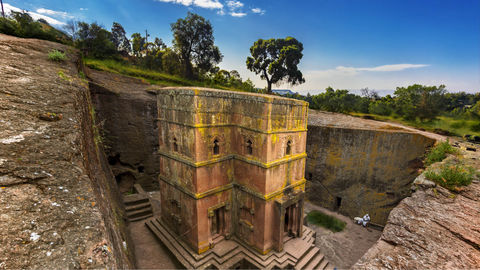
The 800-year-old underground churches in Lalibela town of Ethiopia that are carved from a single stone, make the town a popular tourist destination. By Tanvi Jain
Lalibela, a town in Amhara region of northern Ethiopia has been a UNESCO World Heritage Site since 1978. Home to the 11 medieval monolithic cave churches of Ethiopia, this town is a high place of Ethiopian Christianity, and is considered a pilgrimage even today.
The churches dating to the reign of Ethiopian Emperor King Lalibela (around 1181 to 1221 AD), are Ethiopia’s most popular tourist destinations, and a source of maximum revenue and employment in the town.
Legend has it that the king excavated the churches with the assistance of angels in the 12th century, and their design and layout are inspired from those that the king had observed in Jerusalem.
One interesting thing to note about these 800-year-old churches is that they have all been carved from a single rock of monolithic blocks, which were shaped to form doors, windows, columns, floors, trenches and ceremonial passages — some with openings to hermit caves and catacombs.
Of the 11 churches, while seven are organically embedded in the rock, four are self-standing. It is also said that the churches were built within just 24 years.
There are two main groups of churches – to the north of the river Jordan are, Biete Medhani Alem (House of the Saviour of the World), Biete Mariam (House of Mary), Biete Maskal (House of the Cross), Biete Denagel (House of Virgins), Biete Golgotha Mikael (House of Golgotha Mikael); and to the south of the river lie Biete Amanuel (House of Emmanuel), Biete Qeddus Mercoreus (House of St. Mercoreos), Biete Abba Libanos (House of Abbot Libanos), Biete Gabriel Raphael (House of Gabriel Raphael), and Biete Lehem (House of Holy Bread).
The 11th church, Biete Ghiorgis (House of St. George), is isolated from the others, but connected by a system of trenches.
Bet Medhane Alem is the largest church carved from a single monolith. It is said to be the largest rock-hewn church. Bet Golgotha houses a replica of Jesus‘ tomb and of the manger where Mary gave birth, and Bet Giyorgis is the most iconic church with its singular cruciform design.
The Bet Maryam courtyard connects it to Bet Golgotha and Bet Mikael. The entrance first leads to Bet Mikael, and then to Bet Golgotha. Bet Giyorgis represents the apogee of the rock-hewn tradition, and is the most visually perfect church of all.
Ethiopia has one of the world’s oldest Christian traditions, going back to the fourth century, and is one of the world’s most religious countries. Around 44 per cent of Ethiopia’s population belongs to the Ethiopian Orthodox Tewahedo Church. Around Lalibela itself, about 99 per cent of the population is Orthodox Christian. There are about 1,000 priests and deacons in Lalibela.
Related: Discover The Startling Nuances Of Ethiopian Food










